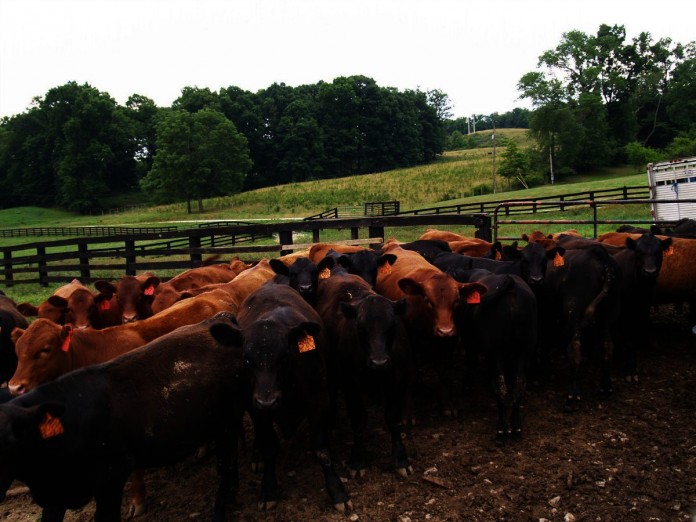SALEM, Ohio — According to Bloomfield Livestock Auction Manager Pete Howes, the U.S. Department of Agriculture’s regulations on interstate livestock disease traceability have been beneficial since going into effect in March 2013.
But implementing those regulations, in Howes’ words, has been “a pain in the butt” for many livestock facilities.
“It’s eliminated a lot of finding out where the cow came from — there is no more monkeying around with people saying ‘this cow didn’t come from here’,” he said. “But it is more work and a lot more paperwork.”
Cleaned up language
The USDA’s Animal and Plant Health Inspection Service, or APHIS, proposed amending language in the traceability regulations Jan. 2.
APHIS officials said the amendments address concerns cattlemen and market managers like Howes have voiced.
The proposed changes include allowing cattle and bison to be moved from a farm of origin without official identification if the animals have been at the farm of origin for at least four months and are going directly to no more than one approved livestock facility or slaughterhouse; allowing cattle and bison to travel interstate without an interstate certificate of veterinary inspection if it has an owner/shipper statement; and allowing cattle and bison to be moved to an approved livestock facility without and owner/shipper statement if the animal’s health records are kept at the livestock facility and made available to USDA officials for five years.
The proposed changes will be open for public comment until March 3.
Neil Hammerschmidt, animal disease traceability program manager for APHIS, said the 2013 animal disease traceability rules, established a decade after the nation’s first confirmed case of bovine spongiform encephalopathy, or “mad cow” disease, are an attempt to modernize the requirement of traceability in cattle populations.
”The primary issue was that the language was outdated,” Hammerschmidt said of updating the rules language. “So in a way, it’s housekeeping.”
Reducing redundancy
Hammerschmidt noted the proposed changes do not ease the ID requirement, but are an attempt to streamline the process — reducing redundancy while still maintaining traceability in cases where cows are being commingled in several livestock facilities.
“We don’t want cattle that are moving from market to market to be exempt,” Hammerschmidt said. “Say you lived in Kansas and you delivered your cattle to a Kansas market and I bought them and brought them to a Nebraska market. The current exemption would allow those animals to go from Kansas to Nebraska without official ID. That commingling makes back tagging more complex.”
Conversely, Hammerschmidt said, if a cow is shipped straight to a slaughter plant, or a single livestock facility, it will already by back tagged to the farm of origin.
“So adding additional identification would not increase traceability,” he said.
Elizabeth Harsh, executive director for the Ohio Cattleman’s Association, said her organization has just begun to dig into the proposed amendments to the traceability rules, but on the surface the changes appear to make the process more user friendly.
“We support traceability and take the health of our herds very seriously and this seems to be a more common sense approach,” Harsh said. “Like changing the wording, for example, from having to have a ‘veterinarian available all day on sale day’ to simply ‘having a veterinarian available.’ It is not really an easing of the regulations, but it should be nicer to deal with.”
Regulating the regulations
Both Harsh and Howes said ensuring compliance among cattlemen and livestock facilities is critical to the success of the traceability program.
“The biggest problem is when the state comes up with a rule, half of these markets don’t comply with it for six or eight months,” Howes said.
Thurman Mullet, manager of the Mount Hope Auction Company in Mount Hope, Ohio, said his facility began using its own tagging system last month, even though the majority of cattle coming through the Mount Hope Auction is from Ohio.
“We even have surveillance cameras in the ring, so if someone said ‘there was a cow in your ring three years ago with this lot number,’ we could bring up a picture of the cow,” Mullet said. “But not every auction is like that.
“The state guys from the Department of Ag have been very helpful to us and are willing to explain changes. But my worry is, five years down the road, how many more changes are there going to be so that you can trace a cow? It could make it impossible to run an auction and we have been doing it with back tags for years with no problems.”
Harsh said versions of the interstate traceability rule have also varied from state to state.
“For example, with exhibition cattle, IDs and vaccination tags are still required,” she said. “But we still have no rule on feeder cattle 18 months or younger.
“We just want (the process) to have more common sense and be more workable.”










